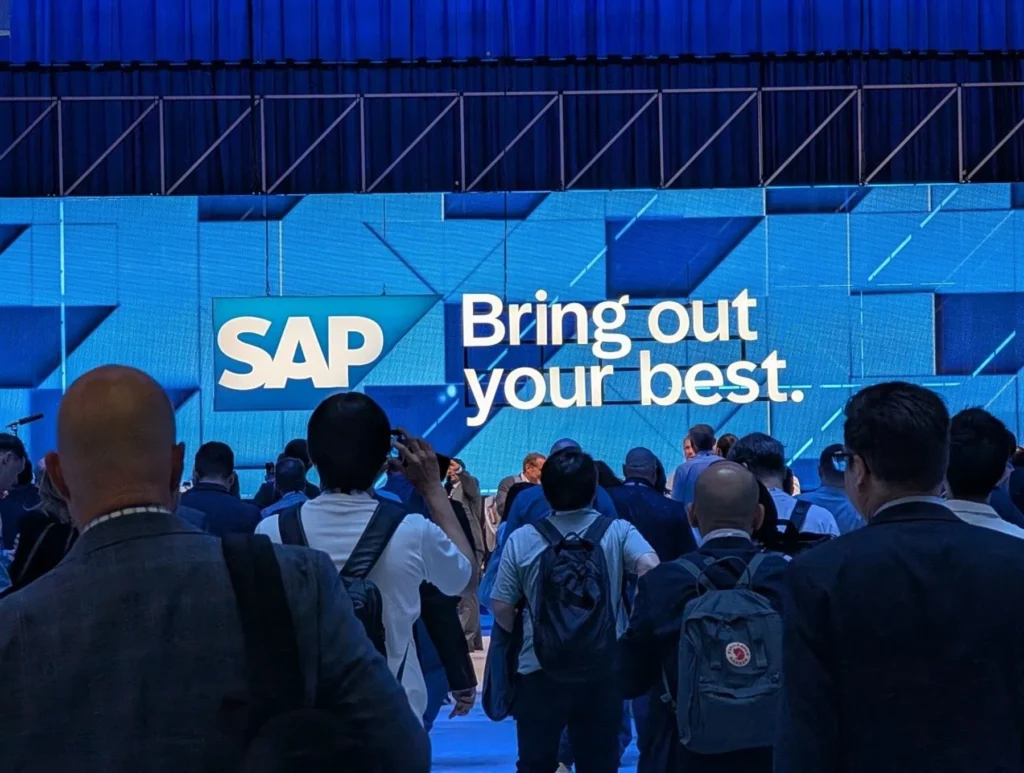March of this year saw the news that process mining vendor Celonis is suing SAP, accusing the ERP giant of claiming unfair business practices over third-party access to data in favor of SAP’s own business process product, SAP Signavio. In response, SAP this month filed a motion to dismiss the claims in U.S. federal court, the company arguing Celonis is attempting to use antitrust laws to gain an unfair advantage in the market.
There’s a lot to unpack here. First, let’s get the obvious out of the way and point out how times have changed between the two German enterprises. Founded in 2011, Celonis began as a spin-off from the Technical University of Munich, the brainchild of Alex Rinke, Bastian Nominacher and Martin Klenk. By 2012, Celonis joined the SAP Startup Focus program. Come 2015, Celonis became the first company from the program to sign a global reseller agreement with SAP, with the former’s process mining tools integrated into SAP environments. According to an archived webpage from the Celonis website, the relationship resulted in over 220 joint implementations across more than 30 countries, including high-profile customers such as 3M, Airbus, and Coca-Cola. On its own, Celonis boasts a prestigious client base, becoming the go-to name in process mining for the likes of PepsiCo, Lufthansa, Jaguar Land Rover, IKEA/Ingka and more.
The shift in affairs arguably occurred in 2021 when SAP acquired Signavio, a Berlin-based business process modeling (BPM) company. The enterprise shares a similar university incubator backstory with Celonis, but with Signavio designed for end users to collaboratively model and redesign processes. The added twist came later when Signavio Process Intelligence was added to the suite, a tool which analyzes logs to uncover process behavior. But with the offering more of a complementary addition, we have to track SAP Signavio’s developments in the last year or so to understand how it may have become a business process kingmaker of sorts between SAP and other vendors in the market.
The Evolution of SAP Signavio
Since SAP’s 2021 acquisition, news on SAP Signavio’s developments in the SAP suite had been somewhat understated. This isn’t remarkable in itself – one can make a comparison now in the developments of LeanIX and WalkMe, more recent additions to the SAP stable which require integration at the right pace. But perhaps the key difference is LeanIX and WalkMe have had the spotlight remain on them, with recent announcements such as those of SAP SuccessFactors/WalkMe integration, and LeanIX winning various awards last year, alongside availability through the UK Government G-Cloud.
SAP Signavio news had been a little muted post-acquisition, especially when comparing LeanIX and WalkMe’s first years as parts of the SAP family. But the irony perhaps is that SAP Signavio’s slow and steady development has led to a little disharmony in Germany – and, more significantly, put an emphasis on the AI-fueled dominion of data currently being pursued by vendors.
The changing market positioning and customer base for SAP Signavio are two such examples. Its recent availability on platforms like AWS Marketplace no doubt augmented Signavio’s visibility and market reach, while the enhanced accessibility and functionality enabled by AI-driven updates aims for a broader customer base, with the potential to encroach on markets traditionally served by competitors. That said, Celonis arguably stands stronger on the AI front since the release of its AgentC agentic AI tools in 2024, to the extent that when thinking of AI in process management, you’re perhaps more likely to picture Celonis than its rivals. Celonis also boasts EMS with AI at its core, using machine learning in its analysis engine (e.g. to cluster variants, predict delays) and in its Action Engine for recommendations.
Going back to the SAP corporate family, we can just take one look at LeanIX’s role with regards to Signavio’s broadening reach, in which AI is not a paramount factor. By combining LeanIX and Signavio, SAP aims to give organizations an all-encompassing view into their processes alongside their IT landscape, the latter courtesy of LeanIX.
 “The synergy between process transparency – enabled by SAP Signavio – and application landscape visibility – powered by SAP LeanIX – offers organizations a clear, end-to-end path from strategy to execution,” according to Johannes Strasser, Global SAP Signavio lead for Westernacher Consulting (pictured). He tells ERP Today that for SAP-centric customers, this can translate into faster insights, stronger alignment between business and IT, and reduced dependence on fragmented third-party tools.
“The synergy between process transparency – enabled by SAP Signavio – and application landscape visibility – powered by SAP LeanIX – offers organizations a clear, end-to-end path from strategy to execution,” according to Johannes Strasser, Global SAP Signavio lead for Westernacher Consulting (pictured). He tells ERP Today that for SAP-centric customers, this can translate into faster insights, stronger alignment between business and IT, and reduced dependence on fragmented third-party tools.
“While some customers still leverage third-party process mining tools for specific use cases, we’re increasingly seeing a shift toward consolidation within the SAP ecosystem for holistic, end-to-end transformation.”
The LeanIX compatibility further bolsters the status of one of Signavio’s tools in SAP Signavio Process Transformation Suite. While originally built around process modeling, the years since the SAP buyout has seen the suite expand to include a process intelligence tool for mining and visualizing real process flows, collaborative BPMN-based design management, a customer experience journey modeler, and process insights for real-time SAP S/4HANA analysis with benchmarks. As a quick comparison, Celonis Process Management also supports BPMN 2.0 (with extended BPMN e.g. requirements, risks, RASCI, auto-layout, etc.) alongside a “Customer Journey” object in its process repository.
According to Strasser, Signavio’s developments reflect how companies today are facing increasingly complex challenges and rapid change across all areas.
“We’re no longer talking about static process models where polished diagrams are seen as mere hygiene factors,” he tells ERP Today. “Instead, it’s about gaining fact-based insights into the actual performance of business processes – insights that support decision-making, enable scenario simulation, and drive effective change even in uncertain times. SAP Signavio is now deeply invested in end-to-end business transformation management, offering capabilities that support holistic process excellence [and at] Westernacher, we’re seeing strong interest in [the solution].”
In Strasser’s view, this interest is often driven by goals such as operational excellence (OPEX), SAP S/4HANA migration, supply chain optimization, or process integration in the context of mergers and acquisitions. But still, Celonis remains arguably hard to beat when it comes to the nitty gritty, such as handling very large event logs and complex object relations, thanks to its object-centric process mining abilities and a proprietary PQL that is well-regarded for custom analyses. Celonis claims 15+ million automations run daily via its engine, and as a whole Celonis is generally viewed as more mature for end‑to‑end automation orchestration, drilling down into end-to-end cost, quality and sustainability metrics.
It’s also worth remembering that another plus point in Celonis’ favor comes without the SAP “baggage”, designed as it is with a modular approach and available with a Free Plan for the not-necessarily SAP-beholden mid-market to trial.
The Data Question
With what SAP is offering on the table, the Celonis lawsuit can be summed up in its claim that customers are being pushed towards SAP Signavio by what it deems to be anti-competitive behavior. For example, limited APIs or obfuscated data structures that, in the Celonis view, may make it difficult for SAP’s competitors to operate effectively, especially in the cloud.
Celonis itself stands strong as ever in the market; recently it has gained Magic Quadrant plaudits in process mining, while its partnership with Microsoft has expanded to include its platform as a workload in the analytics platform of Microsoft Fabric, bringing Celonis ever closer into the lucrative Teams sphere.
But what’s really at the heart of the SAP/Celonis dispute is more AI than the underlying base of process management. More specifically it’s about data control, with regards to who can access business process data inside SAP systems, under what terms, and with what technical and commercial freedoms. As AI becomes increasingly central to enterprise strategy, the ability to access and act on operational data is now a competitive differentiator. The outcome of the lawsuit could help define whether AI innovation in the enterprise remains open and plural or consolidates around a few data gatekeepers.
What this means for ERP Insiders
Celonis vs. SAP: Antitrust Allegations and Ecosystem Tensions. Celonis has filed a lawsuit against SAP, accusing the ERP giant of leveraging unfair practices to promote its own business process platform, SAP Signavio, at the expense of third-party tools. The dispute centers on claims that SAP restricts data access through limited APIs and complex data structures, making it harder for external process mining vendors to operate within SAP environments. The outcome of this case could reshape competitive dynamics in the BPM and process mining space, particularly around data accessibility.
SAP Signavio’s Strategic Growth and Integration. Since acquiring Signavio in 2021, SAP has methodically built it into a comprehensive process transformation suite. Combined with LeanIX, SAP now offers customers a unified view of their business and IT landscapes, and recent advancements have strengthened Signavio’s role in end-to-end digital transformation, positioning it as a central pillar within SAP’s broader enterprise solutions ecosystem.
The Battle for AI-Driven Process Control and Data Ownership. At the heart of the Celonis-SAP conflict is a broader question of who controls access to enterprise data, an increasingly vital asset in AI-powered process optimization. With both companies doubling down on AI and automation, the ability to harness clean, real-time operational data is a key strategic advantage. Celonis continues to grow through alliances like its deepening partnership with Microsoft, while SAP is consolidating its own ecosystem around Signavio and LeanIX. The resolution of this legal battle could determine whether the future of AI in business process management remains open and competitive or shifts toward a model dominated by integrated platform providers.





